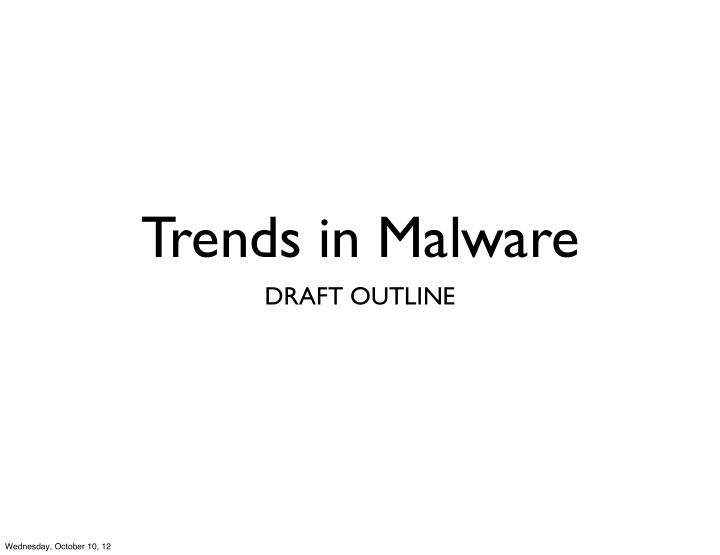



Trends in Malware DRAFT OUTLINE Wednesday, October 10, 12
Presentation Synopsis Security is often a game of cat and mouse as security professionals and attackers each vie to stay one step ahead of the other. In this race for dominance, attackers are developing ever more sophisticated malware exploits. Modern malware increasingly preys on human naivety, burrows deep within operating systems, and is even able to change its own software code to evade detection. In this session we will examine the current malware landscape, looking at who is behind the attacks, how it works, and, most importantly, what we can do to counter the threat. Wednesday, October 10, 12
Recent, High Profile Attacks Attack Strategic Target Facility Adversary Means Result Significance Goal Goal Penetrated security defenses Steal intellectual and obtained Telvent Canada Ltd Electricity Chinese hackers Malware Unknown Undetermined property software and blueprints related to SCADA system First publicly Stated: End Information known case of government Aramco, Saudi Malware destruction, steal hacktivist group Oil Hacktivist Erased hard drives oppression, Arabia (Shamoon) intellectual using state particularly in property developed middle east malware Speculation: Compromised RSA Speculation: Steal Malware (Excel Steal intellectual Acceleration of RSA IT Chinese hackers SecureID token US jet fighter Spreadsheet) property Chinese military generation blueprints from LM capability First publicly known, attributed Halt or delay Delay Iran from Natanz Nuclear US & Israeli Destroyed use of cyber Nuclear Malware (Stuxnet) uranium obtaining nuclear Facility, Iran Government centrifuges weapon by enrichment material national government Wednesday, October 10, 12
Malware Track Record • 2010: On average, only 53% of malware detected on download * • 2011: 250% Increase in unique malware domains ** • 2011: 49% of breaches used malware *** • 2012: On average, 2 new, unique pieces of malware per day **** * 2010 NSS Labs study (www. nsslabs.com) ** 2011 Cisco Global Threat report (www.cisco.com) *** 2011 Verizon Data Breach Investigations Report **** 2012 ZDNET http://www.zdnet.com/blog/bott/the-malware-numbers-game-how-many-viruses-are-out-there/4783 Wednesday, October 10, 12
What is Malware Malware, short for malicious software, is software used or created to disrupt computer operation, gather sensitive information, or gain access to private computer system. - Wikipedia Wednesday, October 10, 12
Characteristics • Proliferate (spread) • Infect (infiltrate) • Conceal (hide) • Compromise (disrupt, exfiltrate) Wednesday, October 10, 12
Malware Types • Virus (self replicates by attaching to another program or file) • Worms (replicates independent of another program) • Trojan Horses (masquerades as legitimate file or program) • Rootkits (gain privileged access to a machine while concealing itself) • Spyware (collect information from target system) • Adware (delivers advertisements with or without consent) Wednesday, October 10, 12
Actors • Government & Military • Organized Crime • Terrorists • Activists • Opportunists (just for kicks, profit, show-off skills) Wednesday, October 10, 12
Early Malware • 1988 - Morris Worm (remotely connect to a UNIX process, overwrite memory (buffer overflow) and gain access to the machine) • 2001 - NIMDA (spread through email or webs. Would modify or replace legitimate files on system and open remote access with admin privileges.) • 2005 - Sony BMG rootkit (Installed by inserting SONY music CD into PC. Designed to prevent copying of CD - XCP . Software hid itself and opened vulnerabilities that subsequent malware exploited) Wednesday, October 10, 12
Traditional Defense • Manual Inspection & Removal (use tools to look for files or settings and remove or restore) • Anti-Virus (look for file or settings signature and remove or restore) • Intrusion Detection / Protection (look for packet types, formats, patterns and block or redirect) • Firewall (filter, permit or deny traffic) • Sandboxing (limit behavior - restrict application rights/ access, lock-down systems, segment networks, etc.) Wednesday, October 10, 12
Modern Malware • Customized & Targeted • Polymorphic (pieces of code in the malware change for each distribution - e.g. shifting encryption, data insertion, changing code run order) • Remotely controlled with encrypted communications (botnets - provide agility and flexibility) • Persistent and intelligent (probe network to find more vulnerabilities, adjust tactics, blend in, low and slow) • Beyond computers (mobile, industrial) Wednesday, October 10, 12
Integrated Attacks 1. Infiltrate: spam, phishing, P2P networks, web browsing, social media, social engineering, 2. Infect: trojan horse, virus, worm 3. Persist & Spread: worm, botnet, rootkit 4. Attack: Steal, SPAM, DDoS Wednesday, October 10, 12
Modern Defense • Architecture (policy, governance, operations, capabilities) • Intelligence-led threat defense, not just vulnerability elimination • Contextual & anomaly-based threat detection • Automated, policy-based enforcement Wednesday, October 10, 12
Security Architecture • Security starts with goals (i.e. what’s important to the business) • Requires policy and governance that aligns with goals • Leverages cyber defense operations that implement policy and governance • Builds on an infrastructure platform that provides trust, visibility & resilience Wednesday, October 10, 12
Intelligence-led Threat Defense • Assess target, adversary, risk, means as a basis for developing defenses • Balance across prevention, preparation, response, and recovery • Build sources of local and global intelligence Wednesday, October 10, 12
Context & Anomaly- based Threat detection • Complexity of modern malware means static, signature-based systems alone do not work • Monitor a broad scope of behaviors to fingerprint attacks • Correlate with risk of compromise Wednesday, October 10, 12
Automated, Policy- Based Enforcement • User, device, location, and resources are no longer fixed • Identity is the new perimeter • Infrastructure must leverage policy to dynamically enforce access as user, device, location, and resources shift Wednesday, October 10, 12
Recommend
More recommend